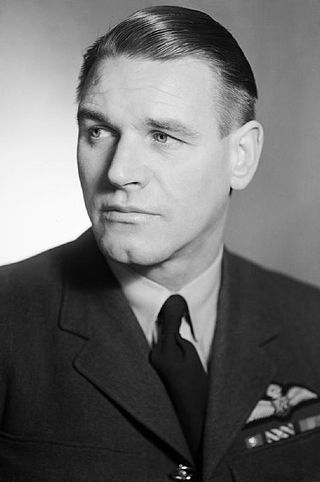
Adolph Gysbert Malan,, better known as Sailor Malan, was a South African fighter pilot and flying ace in the Royal Air Force (RAF) who led No. 74 Squadron RAF during the Battle of Britain. He finished his fighter career in 1941 with twenty-seven destroyed, seven shared destroyed and two unconfirmed, three probables and sixteen damaged. At the time he was the RAF's leading ace, and one of the highest scoring pilots to have served wholly with RAF Fighter Command during the Second World War.

The National Party, also known as the Nationalist Party, was a political party in South Africa from 1914 to 1997, which was responsible for the implementation of apartheid rule. The party was an Afrikaner ethnic nationalist party, which initially promoted the interests of Afrikaners but later became a stalwart promoter and enactor of white supremacy, for which it is best known. It first became the governing party of the country in 1924. It merged with its rival, the SAP, during the Great Depression, and a splinter faction became the official opposition during World War II and returned to power. With the National Party governing South Africa from 4 June 1948 until 9 May 1994, the country for the bulk of this time was only a de jure or partial democracy, as from 1958 onwards non-white people were barred from voting. In 1990, it began to style itself as simply a South African civic nationalist party, and after the fall of apartheid in 1994, attempted to become a moderate conservative one. The party's reputation was damaged irreparably by perpetrating apartheid, and it rebranded itself as the New National Party in 1997 before eventually dissolving in 2005.

General Magnus André de Merindol Malan was a South African military figure and politician during the last years of apartheid in South Africa. He served respectively as Minister of Defence in the cabinet of President P. W. Botha, Chief of the South African Defence Force (SADF), and Chief of the South African Army. Rising quickly through the lower ranks, he was appointed to strategic command positions. His tenure as chief of the defence force saw it increase in size, efficiency and capabilities.

The South African Army is the principal land warfare force of South Africa, a part of the South African National Defence Force (SANDF), along with the South African Air Force, South African Navy and South African Military Health Service. The Army is commanded by the Chief of the Army, who is subordinate to the Chief of the SANDF.

The Royal British Legion (RBL), formerly the British Legion, is a British charity providing financial, social and emotional support to members and veterans of the British Armed Forces, their families and dependants, as well as all others in need.
Liberalism in South Africa has encompassed various traditions and parties.
The Anti-Apartheid Movement (AAM) was a British organisation that was at the centre of the international movement opposing the South African apartheid system and supporting South Africa's non-White population who were persecuted by the policies of apartheid. The AAM changed its name to ACTSA: Action for Southern Africa in 1994, when South Africa achieved majority rule through free and fair elections, in which all races could vote.

The South African Defence Force (SADF) comprised the armed forces of South Africa from 1957 until 1994. Shortly before the state reconstituted itself as a republic in 1961, the former Union Defence Force was officially succeeded by the SADF, which was established by the Defence Act of 1957. The SADF, in turn, was superseded by the South African National Defence Force in 1994.
South African Jews, whether by culture, ethnicity, or religion, form the twelfth largest Jewish community in the world, and the largest on the African continent. As of 2020, the Kaplan Centre at the University of Cape Town estimates 52,300 Jews in the country. The South African Jewish Board of Deputies estimates that the figure is closer to 75,000.

Apartheid was a system of institutionalised racial segregation that existed in South Africa and South West Africa from 1948 to the early 1990s. Apartheid was characterised by an authoritarian political culture based on baasskap, which ensured that South Africa was dominated politically, socially, and economically by the nation's minority white population. In this minoritarian system, there was social stratification, where white citizens had the highest status, followed by Indians and Coloureds, then Black Africans. The economic legacy and social effects of apartheid continue to the present day, particularly inequality.

Victor J. Clapham (-1991) was a South African graphic artist, awarded the Bronze Wolf, the only distinction of the World Organization of the Scout Movement, awarded by the World Scout Committee for exceptional services to world Scouting, in 1976.

The New Republic Party (NRP) was a South African political party. It was formed as the successor to the disbanded United Party (UP) in 1977 and as a merger with the smaller Democratic Party. It drew its support mainly from the then Province of Natal, and tried to strike a moderate course between the apartheid policy of the ruling National Party (NP) and the liberal policies of the Progressive Federal Party (PFP).
The Special Interrogation Group (SIG) was a unit of the British Army during World War II, formed largely of German-speaking Jewish volunteers from Mandatory Palestine. Disguised as soldiers of the German Afrika Korps, members of the SIG undertook commando and sabotage operations against Axis forces during the Western Desert Campaign.

Springbok colours is the name given to green and gold blazers awarded to members of the South Africa national rugby union team. They were historically awarded to teams and individuals representing South Africa in international competition of any sport, following their creation in 1906. With the arrival of South Africa's new post-apartheid government in 1994, the name Springbok was abandoned by the various control boards since they felt that the term had been abused by the previous apartheid governments, and stigmatised by the anti-apartheid movement. An exception was made in the case of the national rugby union team, who have retained the practice of awarding colours.

Internal resistance to apartheid in South Africa originated from several independent sectors of South African society and took forms ranging from social movements and passive resistance to guerrilla warfare. Mass action against the ruling National Party (NP) government, coupled with South Africa's growing international isolation and economic sanctions, were instrumental in leading to negotiations to end apartheid, which began formally in 1990 and ended with South Africa's first multiracial elections under a universal franchise in 1994.
The World Veterans Federation (WVF) is the world's largest international veteran organisation. The federation consists of 172 veterans organizations from 121 countries representing some 60 million veterans worldwide.
This is a list of the famous and notable people from Kimberley, Northern Cape, South Africa.
The South African Legion is the oldest military veterans organisation in South Africa. It is referred to simply as the SA Legion or even 'The Legion' and is one of the largest independent military veterans charities in South Africa.

Western Province Command was a command of the South African Army.
Dorothy Cleminshaw was a South African civil rights activist and anti-apartheid activist. A member of the Liberal Party of South Africa, she was a prominent figure in the Black Sash in the Western Cape, known particularly for her research and advocacy on political detentions, abortion rights, and conscientious objection.












